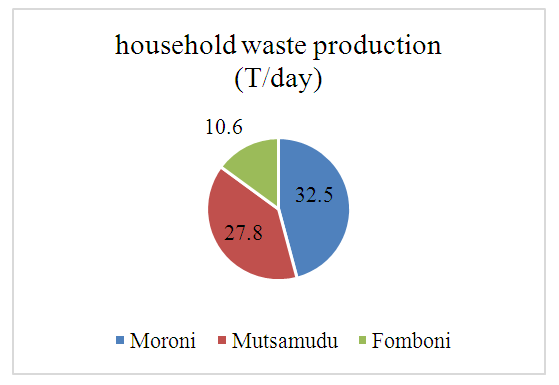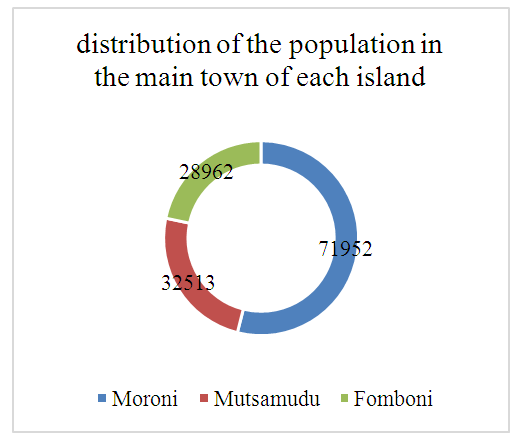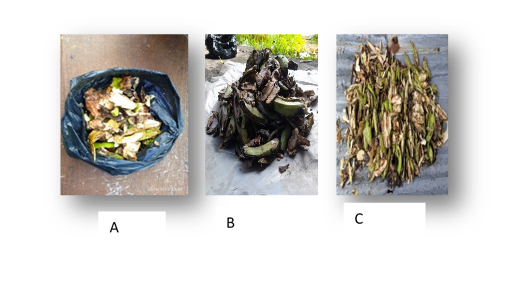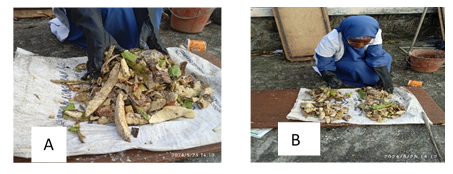| [1] | Ahamadi, M.E., Saindou, A. and Rakotondramiarana, H.T. 2019. Exergetic and Energetic Analysis of a Traditional Semi-Industrial Comorian Ylang-Ylang Essential Oil Wood Fire Distiller. European Journal of Engineering and Technology Research. 4, 5 (May 2019), 67-75. DOI: https://doi.org/10.24018/ejeng.2019.4.5.1256. |
| [2] | Ali Issihaka Ali, Hassan El Bar, Siham Belhadj, Fadoua Karouach, 2015, contribution à l'amélioration des déchets ménagers aux Comores, International Journal of Innovation and Applied Studies. |
| [3] | INSEED, 2018, Résultats provisoires du recensement général de la population et de l'habitat 2017. |
| [4] | Ben Zamyn H. A., Contribution à l'étude de réduction de l'utilisation du bois de chauffe dans l'exploitation de l'huile essentielle d'ylang-ylang de l'ile d'Anjouan: cas de la région de Nioumakele, mémoire de fin d'étude pour l'obtention du diplôme de Licence, Université d'Antananarivo, 2010. |
| [5] | Ahamadi, M. E., & Rakotondramiarana, H. T. (2021). Energy and Exergy Analysis of an Organic Rankine Cycle used for Ylang-Ylang Essential Oil Distillery Waste Heat Recovery for Power Production in Anjouan Island. European Journal of Energy Research, 1(1), 15-24. DOI: https://doi.org/10.24018/ejenergy.2021.1.1.3. |
| [6] | Mohamed Elamin Afilal, Nadia Belkhadir. Caractérisation physicochimique et microbiologique des différents substrats organiques au cours de la fermentation méthanique. Environnement, Ingénierie & Développement, 2011, N°59 - Mars 2011, pp. 9-13. 10.4267/dechets-sciences-techniques.2828. Hal-03172275. |
| [7] | Mathilde Maillot, Dominique Morau, (2023) Physico-chemical characterization of Residual Household Waste for energy recovery in insular territories: Case study of Reunion Island, Wiley, volume 33, issue 1, pp 107-119, DOI: https://doi.org/10.1002/tqem.21989. |
| [8] | C. David Cooper, Brian Kim & John MacDonald (1999) Estimating the Lower Heating Values of Hazardous and Solid Wastes, Journal of the Air & Waste Management Association, 49: 4, 471-476, DOI: https://doi.org/10.1080/10473289.1999.10463816. |
| [9] | Blissbern Appiagyei Osei-Owusu, Martina Francisca Baidoo, Richard Arthur and Sampson OduroKwarteng, (2023) Physico-chemical characterization of selected feedstocks as co-substrates for household biogas generation in Ghana, INTERNATIONAL JOURNAL OF SUSTAINABLE ENGINEERING, VOL. 16, NO. 1, 117-128. DOI: https://doi.org/10.1080/19397038.2023.2214167. |
| [10] | Henry Fisgativa, Anne Tremier, Patrick Dabert, (2016) Characterizing the variability of food waste quality: A need for efficient valorisation through anaerobic digestion, Vol. 50, 264-274. DOI: https://doi.org/10.1016/j.wasman.2016.01.04 1. |
| [11] | Katarzyna Slopiecka , Federica Liberti , Sara Massoli , Pietro Bartocci , Francesco Fantozzi, (2022), Chemical and physical characterization of food waste to improve its use in anaerobic digestion plants, Energy Nexus, vol. 5, 100049. DOI: https://doi.org/10.1016/j.nexus.2022.100049. |
| [12] | Henry Fisgativa, Anne Tremier, Patrick Dabert, (2016), Characterizing the variability of food waste quality: A need for efficient valorisation through anaerobic digestion, Waste Management, vol. 50. 264-274. DOI: https://doi.org/10.1016/j.wasman.2016.01.041. |
| [13] | Camilla M. Braguglia, Agata Gallipoli, Andrea Gianico, Pamela Pagliaccia, (2018), Anaerobic bioconversion of food waste into energy: A critical review, Bioresource Technology, vol. 248. Part A. 37-56. DOI: https://doi.org/10.1016/j.biortech.2017.06.145. |
| [14] | Islam, M.R.; Wang, Q.; Guo, Y.; Wang, W.; Sharmin, S.; Ebere Enyoh, C. Physico-Chemical Characterization of Food Wastes for Potential Soil Application. Processes 2023, 11, 250. https://doi.org/10.3390/pr11010250. |
| [15] | Al-awwal, N.Y.; Ali, U.L. Proximate Analyses of Different Samples of Egg Shells Obtained from Sokoto Market in Nigeria. Int. J.Sci. Res. 2015, 4, 564-566. |
| [16] | Ajala, E.O.; Eletta, O.A.A.; Ajala, M.A.A.; Oyeniyi, S.K. Characterization and evaluation of chicken eggshell for use as a bio-resource. Arid Zo. J. Eng. Technol. Environ. 2018, 14, 26-40. |
| [17] | Shengrong Xue 1,2, Nan Zhao 1,2, Jinghui Song 1,2 and Xiaojiao Wang, Interactive Effects of Chemical Composition of Food Waste during Anaerobic Co-Digestion under Thermophilic Temperature, Sustainability 2019, 11, 2933; doi: https://doi.org/10.3390/su11102933. |
| [18] | Morales-Polo, C.; Cledera-Castro, M.D.M.; Moratilla Soria, B.Y. Reviewing the Anaerobic Digestion of Food Waste: From Waste Generation and Anaerobic Process to Its Perspectives. Appl. Sci. 2018, 8, 1804. https://doi.org/10.3390/app8101804. |
| [19] | Pilarska, A.A.; Kulupa, T.; Kubiak, A.; Wolna-Maruwka, A.; Pilarski, K.; Niewiadomska, A. Anaerobic Digestion of Food Waste-A Short Review. Energies 2023, 16, 5742. https://doi.org/10.3390/en16155742. |
| [20] | Ren, Y.; Yu, M.; Wu, C.; Wang, Q.; Gao, M.; Huang, Q.; Liu, Y. A comprehensive review on food waste anaerobic digestion: Research updates and tendencies. Bioresour. Technol. 2018, 247, 1069-1076. DOI: https://doi.org/10.1016/j.biortech.2017.09.109. |
| [21] | Paritosh, Kunwar, Kushwaha, Sandeep K., Yadav, Monika, Pareek, Nidhi, Chawade, Aakash, Vivekanand, Vivekanand, Food Waste to Energy: An Overview of Sustainable Approaches for Food Waste Management and Nutrient Recycling, BioMed Research International, 2017, 2370927, 19 pages, 2017. https://doi.org/10.1155/2017/2370927. |
| [22] | Pilarska, A.A.; Pilarski, K.; Ryniecki, A.; Tomaszyk, K.; Dach, J.; Wolna-Maruwka, A. Utilization of vegetable dumplings waste from industrial production by anaerobic digestion. Int. Agrophys. 2017, 31, 93-102. DOI 10.1515/intag-2016-0033. |
| [23] | Sidi Ould ALOUEIMINE, (2026), méthodologie de caractérisation des déchets ménagers à Nouakchott (Mauritanie): contribution à la gestion des déchets et outils d'aide à la décision, thèse de Doctorat, Université de Limoges. 195p. |
| [24] | Braun R. and Jaag O. (1970). Methods of Sampling and Analysis of Solid Waste. Eawag, Swiss Federal Institute for Water Supply, Seawage Purification and Water Pollution Control; Section for Solid Wastes; CH- 8600 Dübendorf, Switzerland; 72. |
| [25] | Diop O. (1988). Contribution à l'Etude de la Gestion des Déchets Solides de Dakar: Analyse systémique et Aide à la Décision, thèse de doctorat N° 757, Département de Génie Rural et Géométrie, Ecole Polytechnique Fédérale de Lausanne, Suisse, 292 p. |
| [26] | Tchobanoglous G., Theisen H. et Vigil SamuelA., (1993). I tegrated Solid Waste Management, Engineering Principles and Management Issues; McGraw-Hill International Editions; Civil Engineering Services; 978 p. |
| [27] | Mohee R. (2002). Assessing the recovery potential of solid waste in Mauritius; Resources, conservation and Recycling vol. 36, issue I. 33 - 43. DOI: https://doi.org/10.1016/S0921-3449(02)00011-3. |
| [28] | Kelly E.J. (2002). Solid Waste Biodegradation Enhancements and the Evolution of Analytical Methods Used to Predict Waste stability, thesis, Virginia Polytechnic Institute and State University. |
| [29] | François V. (2004): Détermination d'indicateurs d'accélération et de stabilisation de déchets ménagers enfouis. Etude de l'impact de la recirculation de lixiviats sur colonnes de déchets, thèse de doctorat N° 8-2004, Université de Limoges. |
| [30] | Charnay, F. (2005). Compostage des déchets urbains dans les Pays en Développement: élaboration d'une démarche méthodologique pour une production pérenne de compost. Université de Limoges, Limoges. |
| [31] | Aloueimine S., Matejka G., Zurbrugg C. et Sidi Mohamed M.E., (2005-b). Caractérisation des Ordures Ménagers à Nouakchott: Partie II: Résultats en Saison Sèche et en Saison Humide, article en Presse, 8 pages. |
| [32] | B. C. Khodifad, N. K. Dhamsaniya, (2020), Drying of Food Materials by Microwave Energy - A Review, 9(5): 1950-1973. DOI: https://doi.org/10.20546/ijcmas.2020.905.223. |
| [33] | Singh, P.K., Srichandan, H., Ojha, S.K. et al. Evaluation of biomethane potential of codigested sheep manure and kitchen refuse. Biomass Conv. Bioref. 13, 11879-11889 (2023). https://doi.org/10.1007/s13399-021-01961-5. |
| [34] | WHO (1978). Methods of Analysis of Sewage Sludge Solid Waste and Compost; WHO International Reference Centre for Waste Disposal; CH- 8600 Dübendorf (Suitzerland), 44 p. |
| [35] | Braun R. and Jaag O. (1970). Methods of Sampling and Analysis of Solid Waste. Eawag, Swiss Federal Institute for Water Supply, Seawage Purification and Water Pollution Control; Section for Solid Wastes; CH- 8600 Dübendorf, Switzerland; 72 p. |
| [36] | P. Flyhammar, Estimation of heavy metal transformations in municipal solid waste, Science of The Total Environment, Volume 198, Issue 2, 1997, Pages 123-133, ISSN 0048-9697, https://doi.org/10.1016/S0048-9697(97)05439-9. |
| [37] | Abu-Qudais, M., & Abu-Qdais, H.A. (2000). Energy content of municipal solid waste in Jordan and its potential utilization. Energy Conversion and Management, 41, 983-991. https://doi.org/10.1016/S0196-8904(99)00155-7. |
| [38] | Kathiravale, S., Yunus, M.N., Sopian, K., Samsuddin, A.H., & Rahman, R.A. (2003). Modeling the heating value of Municipal Solid Waste. Fuel, 82, 1119-1125. https://doi.org/10.1016/S0016-2361(03)00009-7. |
| [39] | Lawal, A.I., Aladejare, A.E., Onifade, M. et al. Predictions of elemental composition of coal and biomass from their proximate analyses using ANFIS, ANN and MLR. Int J Coal Sci Technol 8, 124-140 (2021). https://doi.org/10.1007/s40789-020-00346-9. |
| [40] | Phil Kim, (2017), MATLAB Deep Learning: With Machine Learning, Neural Networks and Artificial Intelligence, Apress, ISBN-13 (electronic): 978-1-4842-2845-6, DOI 10.1007/978-1-4842-2845-6. |
| [41] | Michael O. Fagbohungbe, Ben M.J. Herbert, Hong Li, Lois Ricketts, Kirk T. Semple, The effect of substrate to inoculum ratios on the anaerobic digestion of human faecal material, Environmental Technology & Innovation, Volume 3, 2015, Pages 121-129, ISSN 2352-1864, https://doi.org/10.1016/j.eti.2015.02.005. |
| [42] | Paul A. Scherer, Richard Arthur, Sebastian Antonczyk, Accelerated Biomethane Potential assay for straw with artificially flocculated sludge and defined 'synthetic manure', Bioresource Technology Reports, Volume 15, 2021,100787, ISS2589-014X, https://doi.org/10.1016/j.biteb.2021.100787. |
| [43] | Ahmed, Issahaku, Ofori-Amanfo, Dennis, Awuah, Esi, Cobbold, Florence, A Comprehensive Study on the Physicochemical Characteristics of Faecal Sludge in Greater Accra Region and Analysis of Its Potential Use as Feedstock for Green Energy, Journal of Renewable Energy, 2019, 8696058, 11 pages, 2019. https://doi.org/10.1155/2019/8696058. |
| [44] | Shubhra Singh, N. Hariteja, Shilpi Sharma, N. Janardhana Raju, T.J. Renuka Prasad, Production of biogas from human faeces mixed with the co-substrate poultry litter & cow dung, Environmental Technology & Innovation, Volume 23, 2021, 101551, ISSN 2352-1864, https://doi.org/10.1016/j.eti.2021.101551. |
| [45] | Lei Zhang, Wenxiang Ouyang, Aimin Lia, Essential Role of Trace Elements in Continuous Anaerobic Digestion of Food Waste, Procedia Environmental Sciences, Volume 16, 2012, Pages 102-111, ISSN 1878-0296, https://doi.org/10.1016/j.proenv.2012.10.014. |
| [46] | Li, P., Z. Liu, M. Zhao, X. Dai, and W. Ruan. 2020. "Evaluation of Biogas Performance and Process Stability from Food, Kitchen, and Fruit/ Vegetable Waste by Mono-, Co-, and Tridigestion." Energy & Fuels 34 (10): 12734-12742. https://doi.org/10.1021/acs.energyfuels.0c02598. |
| [47] | Michel MAURER, 2004, Le BIOGAZ en Alsace: Potentiel, étude économique, rapport de stage, Ecole Nationale Supérieure d'Ingénieurs Electriciens de Grenoble, 123p. |
| [48] | Marc cyril Kouadio. CARACTERISATION PHYSICO-CHIMIQUE ET ENERGETIQUE DE LA DECHARGE D'AKOUEDO. Génie chimique. Université Félix Houphouët-Boigny (Côte d'Ivoire), 2020. Français. NNT: tel-03799400ff. |









 and
and  respectively be the mass in grams of the initial waste sample to be dried and the mass of the sample after oven drying to a constant mass, the moisture content is defined by:
respectively be the mass in grams of the initial waste sample to be dried and the mass of the sample after oven drying to a constant mass, the moisture content is defined by: 

 the volatile solids content is obtained by the following equation:
the volatile solids content is obtained by the following equation:
 is the mass of the calcined sample
is the mass of the calcined sample

 is specific to each waste and depends on its composition and age. Depending on the author, this coefficient can vary between 0.42 and 0.58. The following table gives different values for this coefficient, depending on the author and the age of the waste [23].
is specific to each waste and depends on its composition and age. Depending on the author, this coefficient can vary between 0.42 and 0.58. The following table gives different values for this coefficient, depending on the author and the age of the waste [23].
 is the substrate mass and
is the substrate mass and  the biogas productivity at 60% methane. Methane production is therefore evaluated by relationship (8):
the biogas productivity at 60% methane. Methane production is therefore evaluated by relationship (8): 
 is obtained by Kouadio [48]. Indeed in their study on the characterization of household kitchen waste they obtained a value
is obtained by Kouadio [48]. Indeed in their study on the characterization of household kitchen waste they obtained a value  The author proposed this value for fruits and vegetables, which is the case in this study. Indeed, the three samples studied in this study are mostly composed by fruit and vegetable peelings. The results for the three samples studied are summarized in the following table:
The author proposed this value for fruits and vegetables, which is the case in this study. Indeed, the three samples studied in this study are mostly composed by fruit and vegetable peelings. The results for the three samples studied are summarized in the following table: and
and  . The methane percentage of the tested waste is around 42% for the 3 samples. This can be explained by the fact that the 3 samples are made up of the same types of waste but at different portions. These results differ slightly from those of some authors [9], a difference which may be explained by the composition of the waste and its geographical origin. However, these results clearly show that Comorian kitchen waste can be valorised into biogas. Analysis of the results shows that, for better production and energy yield, co-management with other wastes with greater potential is essential. It should also be noted that the samples studied in this work are fresh waste. It is quite possible that if they are already decomposed the yield will be even better. This will be the subject of the rest of this work.
. The methane percentage of the tested waste is around 42% for the 3 samples. This can be explained by the fact that the 3 samples are made up of the same types of waste but at different portions. These results differ slightly from those of some authors [9], a difference which may be explained by the composition of the waste and its geographical origin. However, these results clearly show that Comorian kitchen waste can be valorised into biogas. Analysis of the results shows that, for better production and energy yield, co-management with other wastes with greater potential is essential. It should also be noted that the samples studied in this work are fresh waste. It is quite possible that if they are already decomposed the yield will be even better. This will be the subject of the rest of this work. Abstract
Abstract Reference
Reference Full-Text PDF
Full-Text PDF Full-text HTML
Full-text HTML

